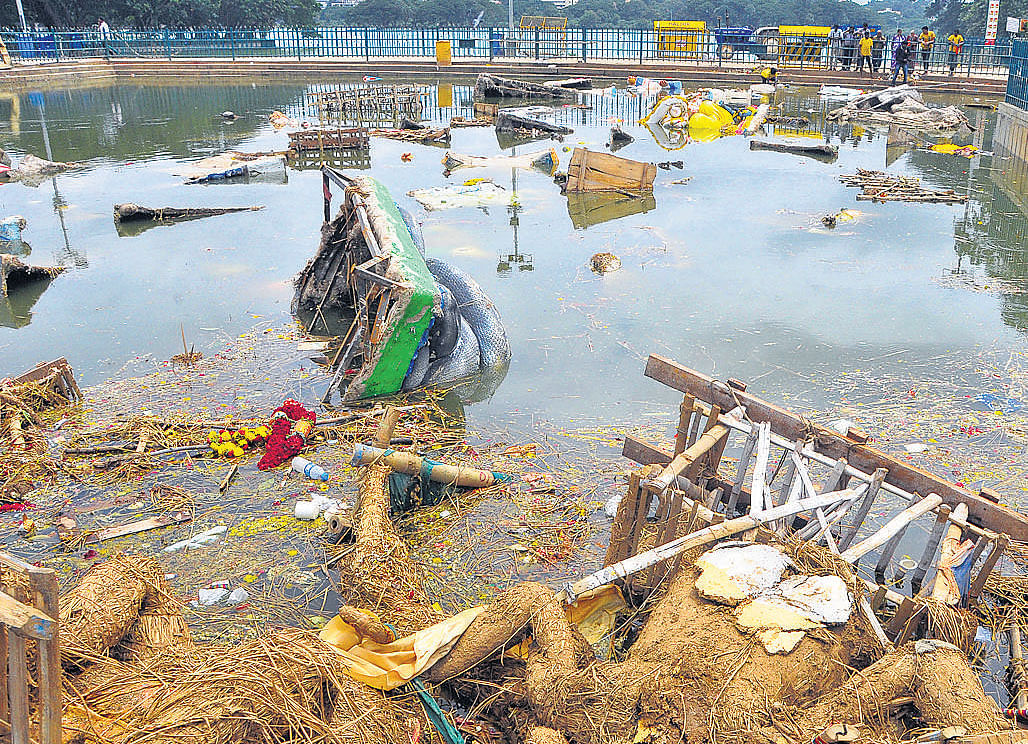
A study conducted by Karnataka State Pollution Control Board (KSPCB) has found high levels of heavy metals in lakes across the City, post immersion of Ganesha idols.
The Board, in its study conducted before and after the Ganesha festival, has found alarming level of contaminants in the lakes despite the awareness drive it conducted on using eco-friendly idols.
According to the KSPCB report, increased levels of chromium and copper were found in lake sediment samples taken from four lakes—Ulsoor, Mallathahalli, Sankey and Yelamallappa.
At Ulsoor lake, the chromium level had increased from 9.8 to 23.2 mg/kg (milligram per kilogram), Mallathahalli—0 to 37.2 mg/kg, Sankey tank—7.8 to 41.3 mg/kg and Yelamallappa lake from 9.22 to 13.5 mg/kg.
The copper content in Madavara Lake, located on Bangalore-Nelamangala Road, had risen to 486.1 from 31.1 mg/kg post immersion. Similarly, at Sankey Tank it had risen to 350.6 from 42.2 mg/kg. The standard limit ranges from 135 to 270 mg/kg.
Analysis of water
Heavy metals were also found in the lake waters. High lead content was found in Lalbagh lake - 0.02 to 0.04 mg/L (milligram per litre). At Madavara Lake it was 0.04 to 0.15 mg/L. The standard lead content limit is 0.1mg/L.
High copper content was found in four lakes—Lalbagh which recorded 0.02 to 0.08 mg/L, Sankey Tank—0.03 to 0.04 mg/L, Madhavara—0.22 to 0.34 mg/L and Hebbal—0.02 to 0.06 mg/L.
High contents of zinc and nickel were found at Madavara lake. While the zinc content varied between 44 and 24 mg/L, nickel was found in the range of 0.04 and 0.09 mg/L. At Lalbagh lake nickel content was found to be 0.02 to 0.04 mg/L. High levels of iron was also found in Byransandra Lake which stood between 0.85 and 3.49 mg/L and at Hebbal Lake between 1.84 and 3.95 mg/L.
High pH value
Besides this, high pH value was found in Shivapura Lake which was between 7.5 and 8.9 mg/L and at Karihobanahalli Lake between 7.4 and 7.9 mg/L. In some places pH value had also reduced due to addition of acidic material Calcium Sulphate (CaSO4) in Plaster of Paris. The standard pH value is 0.01 mg/L.
Bio-chemical Oxygen Demand (BOD) has increased from 8.2 mg/L to 16.9 mg/L on an average in all lakes. As per the classification of Central Pollution Control Board classification, based on primary water quality criteria, lakes in Bangalore city have slipped from Class-D to Below E.
The Dissolved Oxygen (DO) values have also decreased due to immersion of pooja materials. Minimum Dissolved Oxygen level has to be maintained at four mg/L for the existence of aquatic life, anything less than 4.0 mg/L, the aquatic life would die.
The average BOD levels (Organic matter) in the lakes has decreased from 529 per cent to 106 per cent compared to 2013 reports.
Last year, the BOD (Organic matter) recorded was 8.5 to 62 mg/L and this year it stood at 8.2 mg/L to 16.9 mg/L which is four times less than the earlier recording.
Tests were conducted on 12 lakes - Byrasandra, Ulsoor, Shivapura, Karihobanahalli, Lalbagh, Yediyur, Mallathahalli, Sankey, Yelamallappa, Hebbal, Nagawara and Madhavara in the City that were used for immersion of idols.
Highly polluted
Compared to other lakes, the contamination was high in Madhavara lake. The overall dissolved oxygen level decreased in all lakes, KSPCB report.
DH News Service